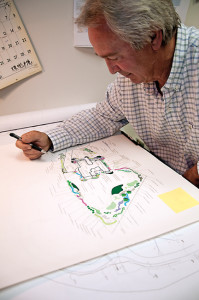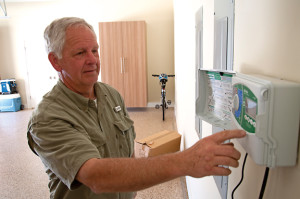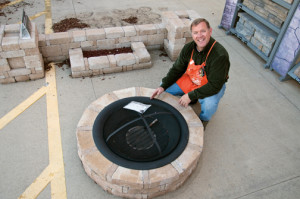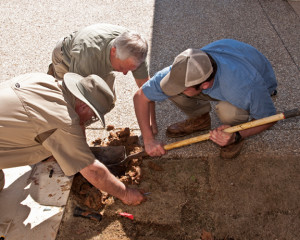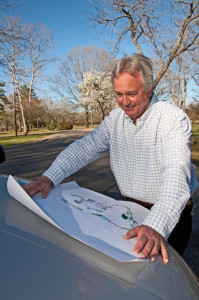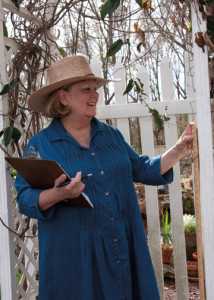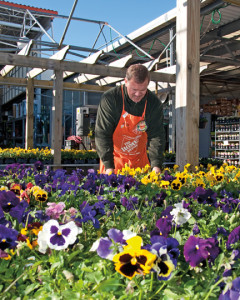Upgrades by the Yard
Posted on April 1, 2014 by bob in Features
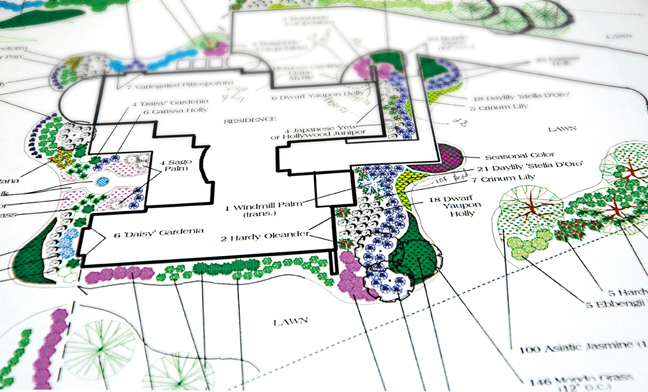 by Jennifer Bowen; photos by Bob Corley
by Jennifer Bowen; photos by Bob Corley
If the arrival of spring has you itching to spend more time outside, making landscaping improvements can give you a reason to indulge your spring fever while increasing your curb appeal. Landscaping is a project that typically appreciates in value. If you’re considering a move, the front yard is the first impression buyers have of your home.
“Good landscaping can easily add 15 percent to a house. And in a lot of cases, more than that,” said Sonny Hodges with Southern Homes and Gardens Landscaping.
“When plants are installed, they then become part of the property value,” Hodges said. “That plays into the neighborhood. Few people realize when they’re doing something around their home, they’re making their neighborhood and community more valuable.”
Depending on your budget and how much time you want to spend, a landscaping project can be as easy or challenging, as dramatic or sedate, as you want it to be.
“We have people who say ‘I want no maintenance.’ Well, there’s no such thing,” said Hodges. “You’re going to have to fertilize it, water it, prune it. You may have to spray it.
There’s criteria that has to be worked into every project.”
If you’re a do-it-yourselfer on a budget, popular spring projects such as pruning or replacing overgrown shrubs and planting flower beds are easy ways to enhance beauty without spending lots of money. Investing $100-$300 on common items like soil, mulch, bulbs and trees, can go a long way. It starts with simple soil preparation.
“Our soil is not good so [people] need to know that up front,” said Charles Harwell with Green Thumb Nursery.
To enrich that not-so-good soil, add some quality potting soil to your existing soil, building a foundation for growth.
“Typically everything will be better if the bed is built up and planted higher. That’s the biggest tip, to not plant anything down in the heavy clay soils we have,” Harwell said. “If you can mix some (potting soil) in, the roots can go from good soil to semi-good soil to the not-so-good soil.”
Adding mulch around flowers reduces weed growth and retains moisture, lessening time spent weeding and watering. For a pop of color, consider a flowering tree that grows well in Alabama’s soil and climate.
“There seems to be a stronger trend going back to camellias for the larger plants to have some color as well as some green,” said Harwell. “Hydrangeas are really big for color for sun and shade, since we have some that will work in full sun and some that work in shade.“
Crepe myrtles, he says, are the easiest flower tree to grow. One that does not grow well in Central Alabama is the dogwood.
“Everybody wants them,” Harwell said, “but we try to discourage dogwoods.”
A popular feature for those looking to create a backyard gathering space is a fire pit, which can be as simple as a sand foundation with flagstone bricks stacked in a circle two to three feet high, overlapping the seams on each level.
“[It costs] all told, probably about $130 and you can have it for years to come,” said Jeff Sweeney with The Home Depot. “It’s very simple; not hard to do.”
Check local codes on fire pits and build them on concrete or dirt, never on a flammable surface. Build away from structures and trees and always have a garden hose nearby.
For those seeking a do-it-yourself challenge, consider a brick walkway. Be warned — this project is labor intensive. It starts with digging out just enough sod to create a flat foundation, then filling in the area with gravel and sand, tamping them down for a compacted surface. Lay your brick and add a border to ensure everything stays put. Sweeney estimates a four foot by 40 foot walkway would cost around $4.85 a square foot.
“Usually a contractor will be around three-and-a-half times that amount to do that,” Sweeney said. “There’s considerable savings there. We’ll be able to show them how to get a correct measurement and keep their costs down based on what they’re trying to do.”
Starting at $500 and up, professional landscapers can turn your yard into a personal canvas, extending flower beds and reshaping them for a more appealing design. They can also save you from making costly mistakes by putting things in the wrong place without considering where sunlight falls during the day (and during different seasons), distance from the house, tree locations, etc., all of which come into play with any landscape project.
“Most people, they’re looking at $500-$2,000 to redo their shrub beds across the front of the house,” said Harwell. “Removing the plants, installing new plants, it just depends on how elaborate they want to do. The more elaborate jobs, we may spend upwards of $10,000. Most of the time, when people see the difference, they want to do more.”
Results will vary depending on the plants you choose and the size of your yard. For many, landscaping becomes as much a project of passion as it is of value-increasing practicality.
“Well over half our customers are repeat customers who continually work on their yards,” Harwell said. “They spend a couple thousand this year, $1,000 next year, $5,000 the next year. As they have money, they call us and tell us to do some more.”
If the budget is no issue, go big with an outdoor entertaining space.
“The number one trend we see right now that people are asking for or have questions about is outdoor living,” Hodges said. “That would include seating, eating areas, basically outdoor rooms. That can be a paved surface, an eating area, a hot tub.”
Ethel Boykin, owner of Art In The Garden, agrees.
“I’m getting a lot of requests for fire pits, patios, seating areas, even outdoor kitchens,” she said. “What could be more fun than sitting around a fire with grandkids roasting marsh mellows and telling stories.”
Hodges estimates you can create an outdoor extension of your home with features like furniture and hammocks, even the possibility of a pond, for $10,000-$20,000. While that may seem like a lot of money, Hodges says much like an indoor renovation, outdoor improvements are an investment not just in your personal happiness, but in your home.
“Usually they say a bathroom or kitchen is anywhere from $10,000-$20,000 on average to remodel,” he said.
“The difference with what we do is it appreciates in value. With a kitchen or bathroom, you’ll get 50-75 percent of that cost back if you sold the home. With landscaping … you start off with a smaller investment and it gets more valuable as it ages.”
Boykin sees an added bonus with an outdoor living space that includes a patio area of brick, stone or stamped concrete — less maintenance.
“Maintaining a patio can be as simple as sweeping off the leaves in the fall,” she said.
Boykin estimates an outdoor space with patio, fire pit and seating areas can cost from $4,000 to $12,000.
To save money on any landscaping project, consider less mature trees and flowers. You’ll pay more for fully developed plants.
“With plants, you buy time with money,” Hodges said. “A plant that’s bigger, you’re buying the time it took, the fertilizer and water to get it to that size. You’re buying time, essentially.”
No matter what your budget, Harwell has one simple tip – just start somewhere.
“Every budget can make a difference.”










